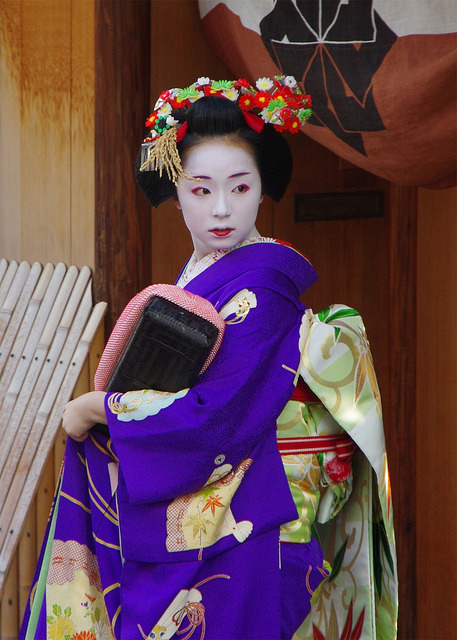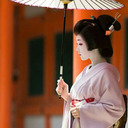Differences between Maiko and Geiko
What is the difference between Maiko and Geiko/Geisha?
Geiko or Geisha are fully-fledged practicioners of the art, they are regareded as fully-fledged artisans. Maiko (or Hangyoku in Tokyo) are apprentices, aspiring to one day become as artistically accomplished as their older sisters.
How can I tell Maiko and Geiko apart?
It is quite easy to tell Maiko and Geiko apart if you know were to look. Their outfits are very intricate and complicated, so there are a lot of small aspects in which they differ.
1. Obi
All Kyoto Maiko wear the darari obi, unless they are wearing a casual kimono. Darari obi are very long and heavy and dangle down in two overlapping “stripes” below the girl’s knee.

A Geiko’s obi, however is much shorter, more than half as short than the Maiko’s darari obi in overall length. It is called “taiko musubi obi”, as the box-like shape reminds some people of the taiko drum.

2. Kimono
While both, Maiko and Geiko wear hikizuri kimono, long, trailing kimono specifically used for dancing, there are still differences between them.
A Maiko’s kimono has very long furisode sleeves that almost touch the ground. A furisode is also the most formal type of kimono that can be worn by unmarried women, which shows that Maiko are no considered as mature women, but still as girls.
A Maiko’s kimono also has tucks at the shoulders, as it is often done with the kimono of children, so they can still wear them when they get older. This, again, is a sign of their childishness.
A Geiko’s kimono, on the other hand, has no tucks, as they are adult women and have reached their full size. Their kimono’s sleeves are also much shorter, they are less than half of the size of thesleeves on a Maiko’s kimono and are in the tomesode style. A tomesode is also the most formal kimono a married woman can wear, signifying a Geiko’s maturity. A Geiko’s kimono is in a special style called kosode.

Overall, a Maiko’s kimono is much more colorful and has bigger motifs. The motifs of a Geiko’s kimono start at the hem and don’t go over the waistline, while a junior Maiko’s kimono has patterns on both shoulders and a senior Maiko’s kimono has a pattern on one shoulder.
3. Hairstyle and hair accessories
Maiko style their own hair, while Geiko wear wigs. Before WWII, Geiko also styled their own hair, but during the 1950s and 60s, Geiko slowly started to wear wigs as wig-making had evloved and wigs (katsura) now basically look real.
Junior Maiko style their hair in the wareshinobu hairstyle, which basically consists of two wings and big bun at the center if the head. A red piece if silk is worked into this bun and pokes out at the top and at the bottom. A special hair ornament, a kanakodome, is placed in the center of the bun.

A junior Maiko also wears a lot of hair ornaments, most notably two big kanzashi, the daikin, the big seasonal kanzashi worn on the left front part of the hair, and the katsuyama bridge, a big, crown-like kanzashi worn just in front of the bun.

Seasonal kanzashi for January worn by Maiko Mikako as a junior Maiko.
First-year Maiko also wear shidare-kanzashi attached to the daikin, whih dangle down the entire side of the face and symbolize youth and childessness.

A senior Maiko wears the ofuku hairstyle, starting usually after 2-3 years of being a Maiko. At first glance, the ofuku hairstyle looks very similar to the wareshinobu hairstyle. It has two wings and a bun in the middle, but there is a rectangular piece of cloth pinned to the bottom of the bun and no red fabric stuck through it.

When a senior Maiko enters the last stage of her apprenticeship, usually after 10 to 12 months of being senior, she stops wearing the katsuyama bridge and starts waring a colorful kushi, a comb, instead, to signify her growing maturity.
A senior Maiko can also wear a number of other hairstyles for special occassions.
A Geiko wears a wig called katsura styled in the taka shimada hairstyle. Only for certain roles during stage performances, she wears wig in a different style and for tea ceremonies before odori, she styles her own hair in the kyoufuu shimada hairstyle.
In the taka shimada hairstyle, the hair is combed back in the front, hangs relatively low on the neck and a small part is modelled into a long braid.

Geiko don’t wear kanzashi anymore, but only small hair ornaments, like the maezashi, the kushi, bekko kogai (hairpin made of tortoiseshell), a tama kanzashi (hairpin made of coral) and hanemotti (thin, silver paper wires that sit atop of the braid).
4. Makeup
The overall look of Maiko’s and Geiko’s makeup isn’t too different, but there are some fine differences.
A first-year Maiko only paints her lower lip red (except for Pontocho) and uses no eyeliner and no black for her eyebrows.

As a Maiko enters her second year, she starts painting both of her lips red and wearing black eyeliner. She also starts using a little bit of black when coloring her eyebrows. Maiko and young Geiko paint their lips on smaller than they actually are; the older they get, the more of their lips their paint red.
Small lips were, and still widely are, considered beautiful in Japan and the coloring of only a small part of the lips also signify youthfullness.

A Geiko uses less red, especially around the eyes, to signify maturity. She also paints in more of her lips and often uses more eyeliner; some Geiko wear real cateyes!

5. Obiage
An obiage is a piece of cloth that peeks our above the obi. It is used to secure the obi and cover up the pattern used to create a flattering shae when wearing a Maiko’s or Geiko’s kimono. A Maiko’s obiage is always red and has a white, seasonal pattern.
In some districts, like Miyagawacho, the obiage is tucked into the obi when the respective Maiko becomes senior to symbolize maturity, in other districts like Gion Kobu, it means that a Maiko will become a Geiko soon.

A Geiko’s obiage is usually white, light beige or red and always tucked into the obi.

6. Eri
Junior Maiko wear eri (collars) with a motif in white, red and gold. In the back, it is red. On the day of her misedashi, her eri is especially patternd; towards the end of her junior-stage, the collar has already become a bit more subdued.

A senior Maiko wears a mostly white eri; only a small part of it in the back is red. Although mostly white, small emroidery is stitched onto the eri.

A Geiko’s eri is completely white and has neither a pattern, nor embroidery stitched onto it.

7. Nagajuban
There are two types of underkimono: The hadajuban, which is the first layer worn against the skin to protect the precious, expensive sik of the kimono from sweat, and the nagajuban, which can be seen when the Maiko or Geiko lifts up her kimono while walking, so it always has to be coordinated with the rest of the kimono.
A Maiko’s nagajuban is always red with a white, seasonal pattern on it.

On an everyday-basis, a Geikos kimono is usually light pink, but yellow, blue or beige or also possible.
For formal occassions, however, the Geiko’s nagajuban usually also has to be red.

8. Footwear
A Maiko’s primary shoes are okobo, high, wooden clogs that have bells inside of them and make a distinctive sound when the Maiko walks. New ones are up to 17 centimeters high, older ones are usually a bit lower, as the wooden soles rub off while walking.

The straps of a junior Maiko’s okobo are always red, the straps of a senior Maiko’s okobo can also be green, blue or pink. Senior Maiko only have to wear okobo with red straps for formal occassions.

A first-year Maiko will almost exclusively wear okobo when out entertaining, unless she has to take a long walk or goes on a trip. This accentuates her childishness.
The older the Maiko gets, the ofter she gets to wear zori, comfortable sandals made of leather and/or rice-straw as a sign of maturity but also as a privilige.

A Geiko doesn’t wear okobo anymore; her ordinary footwear are ordinary geta, again, symbolizing her maturity.

For longer walks, as Geiko can also opt to wear zori.
During the summer, the geta and okobo of Maiko and Geiko are often painted qith black laquer to prevent slipping.
